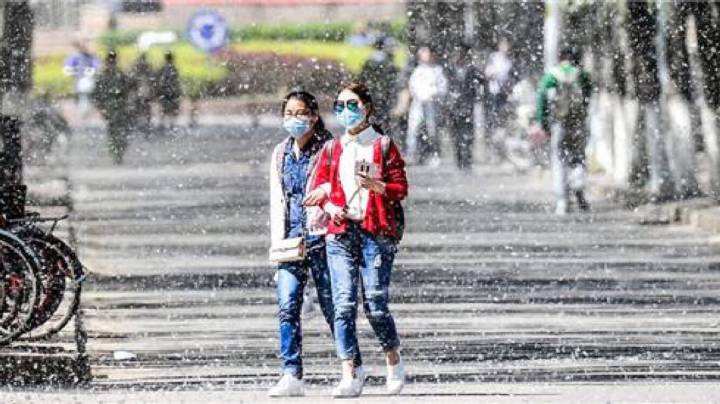These spiney spheres are plant pollen, as seen under a microscope.
这些刺状球体是植物的花粉,在显微镜下的样子。
They're the culprit behind most seasonal allergies.
它们是大多数季节性过敏的罪魁祸首。
Pollen can cause your immune system to kick into overdrive because your body sees the pollen as a harmful intruder.
花粉可能导致你的免疫系统超负荷运转,因为你的身体将它们视为有害的入侵者。
As a result, the body produces histamines.
这样一来,身体就会合成组胺。
Normally, they promote healing by increasing blood flow and inflammation.
通常,组胺会通过增加血流量和炎症来促进伤口的愈合。
But they can lead to the nasty symptoms we associate with allergies—like sneezing, runny noses, and watery eyes.
但也会带来那些讨厌的,被和过敏联系在一起的症状,如打喷嚏、流鼻涕和流眼泪等。
Generally, people who suffer from allergies have it bad for several weeks during certain plants' growing seasons.
一般来说,过敏人群在某些植物的生长季节会出现长达几周的过敏反应。
But because of climate change, the level of pollen in the air is getting much worse.
但由于气候变化的影响,空气中的花粉含量已经越来越高了。
And that's bad news — whether you suffer from allergies or not.
这对大家来说,不管你过不过敏,都是个坏消息。
In order to grow and produce pollen, plants need to generate energy through photosynthesis.
为了产生花粉,植物需要光合作用产生能量。
That requires water, sunlight, and a third necessary ingredient, carbon dioxide.
因而就需要水、阳光和第三种必要成分——二氧化碳。
Carbon dioxide exists naturally in the atmosphere,
二氧化碳大气中自然就存在,
but as we burn fossil fuels like coal in power plants or gasoline in our cars, we're putting more and more CO2 into the air.
但是,随着发电厂燃烧煤炭,汽车燃烧汽油等化石燃料,我们向空气中排放的二氧化碳已经越来越多。
The more carbon dioxide there is in the air, the more plants grow and produce pollen.
空气中的二氧化碳含量越多,植物产生的花粉含量就越大。
Take a look at this graph.
请看这张图。
These bars are the level of carbon dioxide in the atmosphere between 1996 and 2015.
这些条形图显示的是1996年至2015年间大气中二氧化碳含量的变化情况。
And this line is the amount of pollen produced per ragweed plant, a common source of allergens.
这条线是每株豚草——一种常见的过敏原——产生的花粉量。
As carbon dioxide increased, the ragweed produced more and more pollen.
随着二氧化碳的增加,豚草产生的花粉量也在增加。
And pollen is an important part of a plant's reproductive cycle.
而花粉是植物生殖周期的重要组成部分。
So more pollen means more seeds, which means more plants producing more pollen the following season.
所以,更多的花粉就意味着更多的种子,就意味着更多的植物在下一个季节产生更多的花粉。
But CO2 is increasing the level of pollen in another way as well.
问题是,二氧化碳还能通过另一种方式增加花粉的数量。
Carbon dioxide is a greenhouse gas.
二氧化碳是一种温室气体。
And it's called that because it traps the sun's heat energy in the Earth's atmosphere and is helping warm the planet — sort of like a greenhouse.
之所以这么叫,是因为它能把太阳产生的热能吸附在地球的大气层中,加剧地球变暖——把地球变成温室一样的地方。

As the climate warms, there are more days above freezing, which means more time that plants are active and producing pollen.
随着气候变暖,气温高于冰点的天数增多,这就意味着植物生长活跃并产生花粉的时间变长。
This graph shows the number of days with above-freezing temperatures in the US over the past 120 years.
这张图显示了美国在过去120年里气温高于冰点的天数。
In the past 50 years, the US growing season has increased by over 10 days, on average.
过去50年里,美国的豚草生长期平均增加了10多天。
And this isn't happening at the same rate everywhere.
但不是每个地方都是这个速度。
This map shows the increase in pollen season for ragweed between 1995 and 2015.
这张图显示了1995年到2015年豚草花粉季节的增长情况。
While some places, like Texas, didn't see much change in their ragweed pollen season,
虽然德克萨斯等地方的豚草花粉季节并没有特别明显的变化,
most places—especially those in the northern US and southern Canada-saw pollen season increase by almost a month.
但大多数地方,尤其是美国北部和加拿大南部的花粉季节都延长了近一个月。
And this isn't just happening in North America.
而且,不止北美是这样。
Overall, most places around the world are seeing longer growing seasons—and, as a result, more days with pollen as well.
总体来看,全世界大多数地方的豚草生长季节都变长了,所以有花粉的日子也变多了。
Pollen levels and allergies are only going to get worse from here if carbon emissions continue the way they are.
如果碳排放继续这样发展下去,花粉水平和人们的过敏情况只会变得更糟。
This is the current production level of grass pollen, another common allergen source.
这是另一种常见的过敏源——草花粉目前的产量水平。
By 2060, that level is expected to double.
到2060年,这一水平预计将翻一番。
And by 2085, that amount will have more than tripled.
到2085年,这个数字将增至现在的三倍以上。
While allergies can be annoying for the 1 in 5 Americans that suffers from them,
虽然对五分之一的那部分有过敏症的美国人来说,过敏的确很烦人,
they can usually be kept at bay with over-the-counter drugs.
但通常都能用非处方药控制住过敏症状。
But in some, allergic reactions can lead to severe reactions like anaphylaxis, where blood pressure drops and airways start swelling shut.
但有一部分人的过敏反应就非常严重,比如血压下降,气道开始肿胀关闭等。
And pollen grains can wreak havoc on people's lungs, even if they don't suffer from seasonal allergies.
即使是没有季节性过敏反应的人群,花粉粒也能对他们的肺部造成严重的损害。
In the US, Asthma attacks induced by pollen have lead to more than 20,000 emergency room visits per year.
在美国,花粉引起的哮喘发作每年会引发2万多起急诊。
So if for no other reason than to protect your sinuses,
所以,哪怕就为了保护你的鼻窦不为其他,
it's important to reduce the amount of CO2 we're adding to the atmosphere.
减少往大气中排放二氧化碳的量都是很重要的。
It can help curb how much we're warming the planet and it can help slow the pollen-ocalypse.
这不仅可以帮助控制地球变暖的程度,也可以帮助减缓花粉末日的到来。


